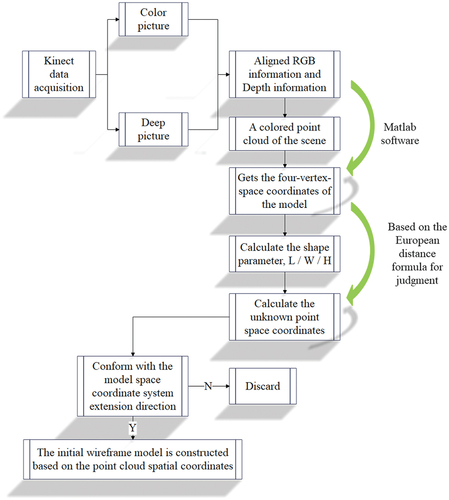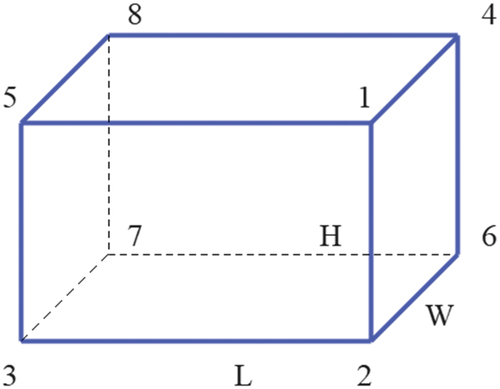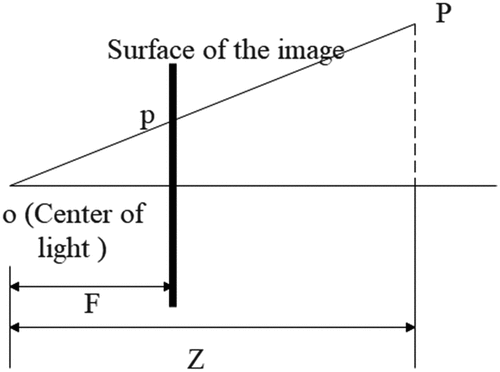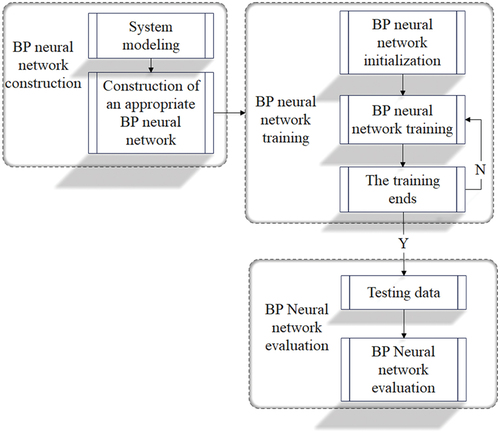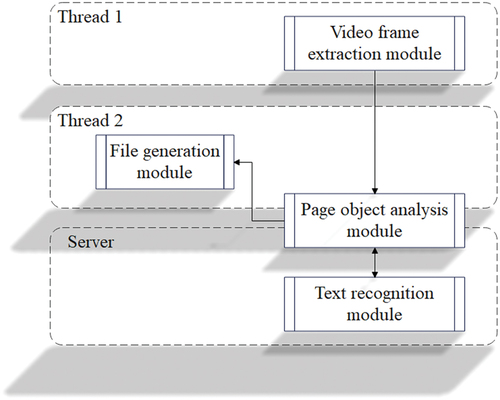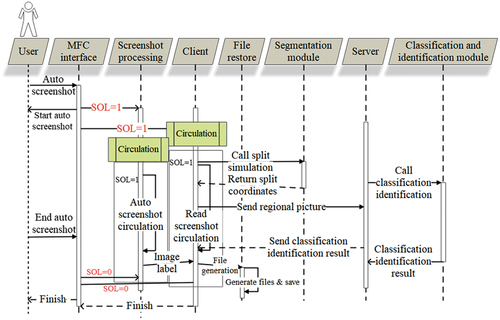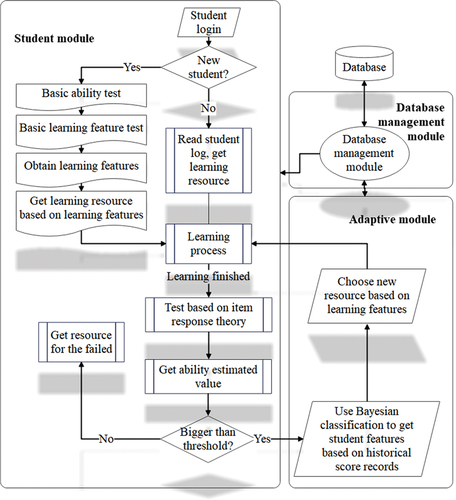 ?Mathematical formulae have been encoded as MathML and are displayed in this HTML version using MathJax in order to improve their display. Uncheck the box to turn MathJax off. This feature requires Javascript. Click on a formula to zoom.
?Mathematical formulae have been encoded as MathML and are displayed in this HTML version using MathJax in order to improve their display. Uncheck the box to turn MathJax off. This feature requires Javascript. Click on a formula to zoom.ABSTRACT
This paper aims to enhance the effectiveness of moral education teaching through an innovative approach. By integrating neural network technology, a data-model-driven three-dimensional initial model construction algorithm was proposed to identify the characteristics of moral education classroom teaching. The 3D space base point and initial value of shape parameters were obtained based on color point cloud data, and the 3D space coordinates of all the vertices of the model were calculated using the Euclidean distance algorithm, resulting in the construction of an initial 3D model. Furthermore, a model of Innovative Moral Education (IME) in higher education was developed based on neural network, and a framework analysis was conducted. Results from simulation teaching research indicate that the IME teaching mode based on the proposed neural network model has a significant practical effect. Overall, this study offers insights into an innovative approach to moral education teaching and contributes to the development of effective pedagogical practices.
Introduction
The rapid expansion of the economy and diversity of interests result in a diversification of values, which is mirrored in the diversification of ideas among students. Some students’ political attitudes and positions are wavering, and incorrect popular opinions in society readily mislead them. Furthermore, some students are apathetic to societal and political events, believing that they have little to do with them and are detrimental to students’ overall growth. In this period, people incorporate and integrate “Internet +” into all aspects of their lives, and they investigate development concepts, models, and unique approaches with their industry features (Trottier Citation2018). From a sociological standpoint, “Internet +” is made up of regular independent people, and it is the collection of knowledge, wisdom, and energy by thousands of people to promote social change, development, and advancement. In the “Internet +” era, everyone has access to the resources they require and a platform to communicate their thoughts and opinions and express their unique voice (Assumpção et al. Citation2018). “Internet +” employs multiple communication carriers as the medium, employs digital information technology, employs general Internet thinking, links mobile clients, and efficiently distributes information through multimedia formats such as graphic and audio-visual materials and in progress. People in the new era can hunt for new growth points, obtain new development space and chances, and communicate and showcase to meet tailored development desires through the network platform (Chatterjee, Kar, and Mustafa Citation2021).
The integration of “Internet +” and education not only refers to the specific application of Internet technology in the field of education, but also a major revolution in the field of education. Some people think that “Internet + education” is “smart education.” This modern educational method has brought unprecedented opportunities for all kinds of education. It meets the learning needs of modern people in the new situation.Education has also brought unprecedented challenges. Learning methods all bring a certain impact (Grossi et al. Citation2018).
The educational setting is “networked.” The deep integration of “Internet +” and education has resulted in a campus life for students with “no Internet presence,” The Internet has had a big impact on students, attracting worldwide attention. With the advent of the “Internet +” era, ideological and political educators increasingly transitioned from knowledge imparters to instructors and servicers of students’ learning. In contrast, students transitioned from passive recipients of knowledge to active constructors. The primary body of education has been realized during this process. The effective connection with the educational object emphasizes the subjectivity of education even more. Educational subjects have a high level of participation. Educational activities in the “Internet Plus” age have a more contemporary feel. Micro-classes flipped classrooms, and efficient classes are all examples of network-related teaching approaches used in ideological and political courses (Pangrazio and Sefton-Green Citation2020). In a student-centered classroom, students are motivated to participate and interact with teachers. They are eager to express their opinions and views and have an equal dialogue with teachers. In a free and open educational environment, in specific educational practice, based on the meaning and basis of common activities, construct social and psychological conditions that are conducive to teacher education and student learning (Walsh Citation2020).
Educational synergy is gradually formed. School education occupies a dominant position in the education of young people. The most effective education is an all-round and three-dimensional education model. Building the joint force of school, society and family education has always been an important force in the search for successful education. Under the integration of “Internet +” and education, we can usually see the same communication platforms such as “School News” and “College Communication,” which can release information and contact parents to understand students’ situation in the first time. As an indispensable bridge for moral education teaching, network carriers can be effectively used in the context of education in the new era, and it is of practical and far-reaching significance to find a promotion mode suitable for moral education teaching (Wiggins and Wilbanks Citation2019).
The integration of “Internet +” and education can effectively promote the informatization of education, especially the development of modern educational technology. Modern educational technology is the theory and application of computer-centered educational technology in education and teaching. It mainly expresses its innovation in educational means, educational media and educational facilities. The educational informatization mentioned here refers more to the application of educational technology in actual education and teaching, which mainly includes (Budiharto and Meiliana Citation2018): rich educational resources, interoperable communication platforms, and innovative educational forms. Under the foreshadowing of educational informatization, network media has become an important carrier of moral education teaching. While providing massive information and technology for moral education, we must first apply the concept of physiological and psychological development, and fully consider the feasibility of education implementation; Secondly, it is necessary to connect the subject and object of education, which is easy to operate and easy to accept. Moral education is a two-way interaction process between teachers and students. Education informatization is not only reflected in the technical support provided by information technology for education, but also in the specific implementation of the information platform in the field of education (Berendt, Littlejohn, and Blakemore Citation2020). Only by connecting and interacting between moral education teaching and students through effective information, so as to influence each other and work together, can education informatization be implemented and become a “booster” for the practical activities of moral education education and teaching, helping the subject and object of education Build a bilateral platform for informatization (Ferguson and Caplan Citation2021).
Communication and cooperation are the most effective and straightforward ways to help pupils grow and progress in daily learning. The “Internet Plus” era creates conditions for sharing and collaboration in moral education, and its role is becoming more prominent. “Internet + education” creates a network platform for exchanges and cooperation between teachers and students, between teachers, and between schools, as well as extensive teaching resources for moral education courses. The extensive network of resources overcomes traditional education’s limits in terms of teaching resources, and its qualities of promptness, speed, and wide diffusion also make it possible for both educational parties to master educational resources in a short period. More specifically, using rich network resources to carry out moral education teaching activities can improve the effectiveness and attractiveness of moral education teaching while also achieving subtle benefits (Saltz and Dewar Citation2019). Innovating the teaching form of moral education, the convenience and interactivity of the Internet have become the first choice for people to find resources. We can check the portal websites of each school, and we can also publish educational information through the school’s official website, Weibo and WeChat; through parents Groups and student groups guide students to discuss and express their opinions; establish a guidance mechanism to enrich the teaching forms of moral education (Ford et al. Citation2020).
Teachers’ understanding of students is no longer limited to “static” understanding in the classroom, but to understand students from multiple perspectives. The so-called dynamic understanding refers to the timely grasp of the changes and progress of students in all aspects. Such as learning progress, changes in homework completion, organizational discipline, changes in hobbies, changes after being praised, criticized, and disputes and conflicts between classmates (Alfano, Higgins, and Levernier Citation2018). Build a network platform, set up class Weibo, WeChat groups, etc., publish hot spot announcements in a timely manner, popularize current affairs education knowledge, and understand students’ ideological trends; carry out hot spot browsing and tracking, find the websites and hot spots that students browse the most, and understand students’ activities Pointing to, to find out the possible problems of students in time, such as whether they are addicted to online games or misled by bad websites, and whether there are bad mental health activities. Timely feedback to the classroom, combined with classroom education. By establishing an effective defense and diagnosis mechanism, cooperating with classroom education, and building a dynamic link of moral education subjects through online and offline education models (Livingstone Citation2019).
This paper combines the neural network technology to carry out the innovative development of the moral education teaching mode, and effectively promote the further development of the moral education teaching mode.
Character Recognition of Moral Education Teaching
Model Initial Value Acquisition Algorithm Driven by Color Point Cloud Data
Flow chart of initial value calculation of model parameters is shown in . The main flow chart of the initial value algorithm for obtaining the point cloud data calculation model based on Kinectv2 is as follows:
The algorithm passes the Kinectv2 and calls the SDK to obtain the depth photo and color photo of the measured scene;
The algorithm aligns the depth photo and the color photo under the same viewing angle to obtain depth information and its corresponding color (RGB) information, and then the color point cloud of the measured scene can be constructed;
Through the acquired color point cloud, the algorithm manually selects a base point of the cuboid object to be measured in the scene (that is, the vertices of the model are located on the model, and the number of fixed points obtained by different models is different) and auxiliary points (the corner points that assist in calculating the shape parameters of the model) to determine the initial parameters of the model, including the coordinate parameters (X, Y, Z) of the base point and the shape parameters of the model length (L), width (W), height (H);
Through the initial parameters of the known model base point, that is, the coordinate parameters (X, Y, Z) and its shape parameters (length, width, height), the coordinates of the unknown point are calculated according to the Euclidean distance in the three-dimensional space, and the algorithm obtains two sets of solutions of an unknown vertex, judges the relationship between the solutions of the two sets of coordinate points and the model space CS, and finally constructs the initial model of the regular cuboid.
Kinectv2 refers to the second version of Microsoft’s motion sensing input device, the Kinect. It was released in 2014 and is designed to be used with the Xbox One and Windows 8.1 or later. The Kinectv2 features improved hardware over its predecessor, including a 1080p camera, increased depth sensing capabilities, and an expanded field of view. It also includes improved skeletal tracking, voice recognition, and gesture recognition, allowing for more advanced user interactions with games and applications. The device has been used for a wide range of applications beyond gaming, including in healthcare, education, and robotics, due to its advanced motion tracking capabilities.
The Kinectv2 depth image generation principle is that the sensor based on digital imaging technology can measure the distance between the entire scene and the sensor. These distance values are stored directly in a matrix whose size corresponds to the resolution of the depth sensor. In fact, for each pixel of the 512 × 424 depth image, the measuring device estimates the distance value to the corresponding target point in real time. This output data is the depth image, which is a 2D image from which the 3D coordinates of the scene can be calculated.
Kinectv2 each has its own inherent depth parameter. Since Microsoft releases both the Kinect sensor and its official software development kit (Software Development Kit, SDK), it allows to develop solutions for many tasks. Therefore, in this article, we use the third-party compiler Matlab to obtain this parameter through camera calibration.
The fixed-focus color camera and depth camera parameters of Kinectv2 are fixed, but located in different positions. Therefore, before obtaining the 3D point cloud data, we need to use the MapDepthFrameToColorSpace function in Kinectv2 to align the depth image and the color image in the same perspective:
MapDepthFrameToColorSpace(512 × 424, depthData, 512 × 424.m_p ColorCoordinates);
Through the alignment of the two perspectives, we can obtain the image sequence of the depth image representing depth information and the color image representing color information under the same perspective. A color photo with a resolution of 1920 × 1080 can correspondingly obtain 1920 × 1080 pixels. Since each pixel of the depth image represents the value of the corresponding point cloud, 1920 × 1080 three-dimensional coordinate points can be obtained accordingly, and the calculated number of point clouds is 217,088 points. Based on this, the six-dimensional point cloud dataset R, G, B, X, Y, and Z of the Kinectv2 shooting scene can be obtained, and RGB represents the color value of a certain point in the space. XYZ represents the three-dimensional spatial information of the point, and RGB and ATZ are in one-to-one correspondence. The three-dimensional space information can be calculated from the depth image and the camera’s internal parameters, and the color information can be obtained from the color photo.
Calculation of Initial Value of Regular Cuboid Model Parameters
Regular cuboid objects often seen in real-life indoor scenes have different appearances and textures. However, it has regularity and symmetry in shape and structure, which makes it possible to describe simple geometric cuboids based on point cloud data-driven models. Generally speaking, one base point and three auxiliary points of the known model can uniquely determine a cuboid.
Parameter description of the cuboid model as shown in ,the distance relationship between the unknown point 4, point 5, point 7, and point 8 of the tested model and the known points is as follows:
When ;
When ;
When ;
When ;
By subtracting formula (6) from formula (5) and formula (7) from formula (6), we get:
The expressions of and
about
can be derived by taking
as a known value by combining (8) and (9). Then, it can be substituted into any one of formula (5), formula (6) and formula (7) to obtain the one-dimensional quadratic expression equation about
:
Among them,
This part of the content will be discussed in the article’s model image registration based on generalized point photogrammetry theory.
Model Coordinate Transformation
The 3D modeling driven by data-model is to build a model after obtaining the spatial 3D information of the object, and then register it with the image to achieve the purpose of 3D modeling. In this process, a series of coordinate system (CS) transformations are involved.
The Kinectv2 sensor CS is the spatial CS where the current camera is located.
The image plane CS is the plane rectangular CS determined by the internal frame of the Kinectv2 camera, which is used to describe the spatial position of the image point and the projection center. The main point is the origin, and the X and Y axes are respectively a CS parallel to the edge line of the image frame, which is a two-dimensional right-handed rectangular CS ().
The CS of the computer monitor is recorded, including the entire screen, and the upper left corner of the screen is (0,0), which is a left-handed CS.
The CS transformation involved in 3D modeling driven by data-model mainly includes: the projection from the three-dimensional space to the two-dimensional plane, and the conversion between the two-dimensional plane CS, as shown in .
The content of this section mainly discusses the conversion between the three-dimensional space and the two-dimensional space CS, that is, the conversion between the RGB camera space CS and the image plane CS of the model driven by point cloud data. There is a point P in the RGB camera space, and the coordinates of the point P in the RGB camera space are (X, Y, Z), F is the distance from point p to optical center o, and the pixel coordinates of p are (x, y), as shown in .
From , we can know that this is a regular relationship of similar triangles, from which we can get:
If the coordinate of the image principal point corresponding to the optical center on the image is , then:
The acquisition of camera internal parameters can be achieved through camera calibration, and the checkerboard method is generally used for camera calibration. By formula (15), the three-dimensional space coordinates of the point cloud can be converted into the two-dimensional coordinates of the image plane to achieve the purpose of model and image registration.
The IME Cultivation Mode in Colleges and Universities Based on the Perspective of Neural Network
By adjusting the training algorithm, finding the optimal evaluation effect is the evaluation model. The training effect of the model is judged by the coefficient of determination and relative error. The whole process is shown in .
The connection diagram between each module is shown in . The page object analysis module is the main module of the system. Among them, the segmentation part runs on the client side, and the classification part is deployed on the server side, which can call the text recognition module on the server side, and transmit the final result information to the file recovery module to generate editable electronic documents.
The sequence diagram of the system is shown in . Because automatic screen capture covers all functions, only the sequence diagram of automatic screen capture is shown here. First, the user manipulates the MFC interface to enable the automatic screenshot mode, the MFC interface pops up feedback, and sends a start message to the screenshot image processing module and the client module. At this time, both the automatic screen capture and the client module create a new thread, and perform screen capture and processing operations in a loop. The two threads transmit information such as sol and picture number through shared memory. The client module reads the picture according to the number for processing. Each time the client module reads a picture, it calls the segmentation model to obtain the region segmentation coordinates, and transmits the segmented region picture to the server through Socket communication. The server calls the classification and recognition model to classify and recognize the regional images and transmit the results to the client. The client then invokes the file generation module to generate the classification and recognition results into docx documents.
When students enter the system, they first need to verify their identity. If it is the first time to log in, it is necessary to test its basic ability and basic learning characteristics, and extract appropriate resources based on the results obtained, and students begin to enter the learning process. If the student already has a learning record, they can choose whether the purpose of this session is to study or to take a test. For students who choose the “Learning” branch, the system will extract their learning breakpoints, and recommend reasonable learning resources for them by matching their learning situation and preferences, and then enter the learning process. If the student chooses the “Testing” branch, or when the student has completed the assigned learning content, they will move to the testing process. If the student’s ability reaches the expected target, the adaptive model will update the student’s learning characteristics and recommend appropriate resources for the student to enter further learning content. Otherwise, students should continue to study the content that they did not pass. The system will track and analyze the learning situation of students, as shown in .
The model is tested to explore the practical effect of the IME teaching model based on the neural network model, and the teaching efficiency of the model is carried out in combination with the simulation evaluation method, and the evaluation results shown in are finally obtained.
Table 1. The practical effect of IME teaching mode based on neural network model.
Based on , the practical effect of the IME teaching mode based on the neural network model appears to be positive. The table shows a range of teaching effects measured in terms of percentage scores (ranging from 79.04% to 88.96%) for 72 different teaching scenarios. The average score appears to be around 84%, which suggests that the IME teaching mode based on the neural network model is effective. Additionally, the range of scores is relatively narrow, with most scores falling within the 80–88% range, which indicates that the teaching mode is consistently effective across different scenarios. Overall, the results suggest that the innovative moral education cultivation model based on neural networks proposed in this study has a good practical effect.
Conclusion
In conclusion, the teaching of moral education is a fundamental aspect of guiding students to establish a correct political position and direction in the process of education. By adhering to the guiding position of Marxism and the development needs of socialism with Chinese characteristics, this research offers a multi-faceted comparison of pluralistic values, helping students view them with a rational and critical perspective. The study demonstrates the correctness of the core socialist values and emphasizes the importance of using various teaching methods and means to improve students’ political awareness and sense of responsibility. By combining neural network technology, this research proposes an innovative approach to moral education teaching, the IME teaching model. Through simulation teaching research, the practical effectiveness of the model is demonstrated, offering new insights into the development of effective pedagogical practices for moral education in higher education.
Disclosure Statement
No potential conflict of interest was reported by the author.
Additional information
Funding
References
- Alfano, M., A. Higgins, and J. Levernier. 2018. Identifying virtues and values through obituary data-mining. The Journal of Value Inquiry 52 (1):59–1504. doi:10.1007/s10790-017-9602-0.
- Assumpção, T. H., I. Popescu, A. Jonoski, and D. P. Solomatine. 2018. Citizen observations contributing to flood modelling: Opportunities and challenges. Hydrology and Earth System Sciences 22 (2):1473–89. doi:10.5194/hess-22-1473-2018.
- Berendt, B., A. Littlejohn, and M. Blakemore. 2020. AI in Education: Learner choice and fundamental rights. Learning, Media and Technology 45 (3):312–24. doi:10.1080/17439884.2020.1786399.
- Budiharto, W., and M. Meiliana. 2018. Prediction and analysis of Indonesia presidential election from Twitter using sentiment analysis. Journal of Big Data 5 (1):1–10. doi:10.1186/s40537-018-0164-1.
- Chatterjee, S., A. K. Kar, and S. Z. Mustafa. 2021. Securing IoT devices in smart cities of India: From ethical and enterprise information system management Perspective. Enterprise Information Systems 15 (4):585–615. doi:10.1080/17517575.2019.1654617.
- Ferguson, K., and A. Caplan. 2021. Love thy neighbour? Allocating vaccines in a world of competing obligations. Journal of Medical Ethics 47 (12):20. doi:10.1136/medethics-2020-106887.
- Ford, E., M. Oswald, L. Hassan, K. Bozentko, G. Nenadic, and J. Cassell. 2020. Should free-text data in electronic medical records be shared for research? A Citizens’ Jury study in the UK. Journal of Medical Ethics 46 (6):367–77. doi:10.1136/medethics-2019-105472.
- Grossi, V., B. Rapisarda, F. Giannotti, and D. Pedreschi. 2018. Data science at SoBigData: The European research infrastructure for social mining and big data analytics. International Journal of Data Science and Analytics 6 (3):205–16. doi:10.1007/s41060-018-0126-x.
- Livingstone, S. 2019. AudieNces in an age of datafication: Critical questions for media research. Television & New Media 20 (2):170–83. doi:10.1177/1527476418811118.
- Pangrazio, L., and J. Sefton-Green. 2020. The social utility of “data literacy. Learning, Media and Technology 45 (2):208–20. doi:10.1080/17439884.2020.1707223.
- Saltz, J. S., and N. Dewar. 2019. Data science ethical considerations: A systematic literature review and proposed project framework. Ethics and Information Technology 21 (3):197–208. doi:10.1007/s10676-019-09502-5.
- Trottier, D. 2018. Scandal mining: Political nobodies and remediated visibility. Media, Culture & Society 40 (6):893–908. doi:10.1177/0163443717734408.
- Walsh, J. P. 2020. SocIal media and moral panics: assessing the effects of technological change on societal reaction. International Journal of Cultural Studies 23 (6):840–59. doi:10.1177/1367877920912257.
- Wiggins, A., and J. Wilbanks. 2019. The rise of citizen science in health and biomedical research. The American Journal of Bioethics 19 (8):3–14. doi:10.1080/15265161.2019.1619859.

